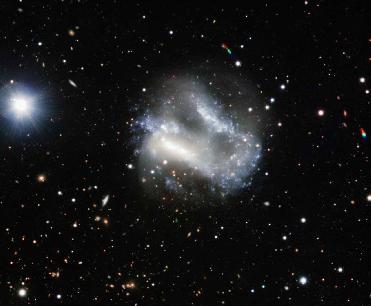
A Curious Pair of Galaxies. ESO image
PARIS (BNS): There are hidden surprises in Arp 261, a catalogue of Peculiar Galaxies that appeared in the 1960s. Using the FORS2 instrument on ESO’s Very Large Telescope, the mystery has been cracked. The ESO image highlights a strange and chaotic duo of interwoven galaxies. The images also contain some surprises, interlopers both far and near.
According to ESO or European Organisation for Astronomical Research in the Southern Hemisphere, Arp 261 lies about 70 million light-years far away in the constellation of Libra, the Scales. “Its chaotic and very unusual structure is created by the interaction of two galaxies that are engaged in a slow motion, but highly disruptive close encounter. Although individual stars are very unlikely to collide in such an event, the huge clouds of gas and dust certainly do crash into each other at high speed, leading to the formation of bright new clusters of very hot stars,” the agency said.
It said that the paths of the existing stars in the galaxies are also dramatically disrupted, creating the faint swirls extending to the upper left and lower right. Both interacting galaxies were probably dwarfs not unlike the Magellanic Clouds orbiting the galaxy, ESO said.
Scientists said that Arp 261 was an unusual exploding star, called SN 1995N, that is thought to be the result of the final collapse of a massive star at the end of its life, a so-called core collapse supernova. “SN 1995N is unusual because it has faded very slowly -and still shows clearly more than seven years after the explosion took place! It is also one of the few supernovae to have been observed to emit X-rays. It is thought that these unusual characteristics are a result of the exploding star being in a dense region of space so that the material blasted out from the supernova ploughs into it and creates X-rays,” ESO said.
Scientists said that apart from the interacting galaxy and its supernova, it also contains several other objects at wildly different distances. “Starting closer home, two small asteroids, in the Solar System between the orbits of Mars and Jupiter, happened to cross and show up as the red-green-blue trails. The trails arise as the objects are moving during the exposures and also between the exposures through different coloured filters. The asteroid at the top is 14670 and the one to the left is 9735. They are probably less than 5 km across. The reflected sunlight from these small bodies takes about 15 minutes to get to the Earth,” the scientists explained.
The ESO said that the next closest object is probably the apparently bright star at the bottom. It may look bright, but it is still about 100 times too faint to be seen with the naked eye. It is most likely a star rather like the Sun and about 500 light-years from us - 20 million times further away than the asteroids. Arp 261 itself, and the supernova, are about 140,000 times further away again than this star, but still in what astronomers would regard as our cosmic neighbourhood, ESO said. Much more distant still, perhaps some 50 to 100 times further away than Arp 261, lies the cluster of galaxies. There is no doubt, however, that a much more remote object lies, unrecognised, amongst the faint background objects seen in this marvellous image, ESO added.
 Previous Article
Previous Article Next Article
Next Article













The Indian Air Force, in its flight trials evaluation report submitted before the Defence Ministry l..
view articleAn insight into the Medium Multi-Role Combat Aircraft competition...
view articleSky enthusiasts can now spot the International Space Station (ISS) commanded by Indian-American astr..
view article